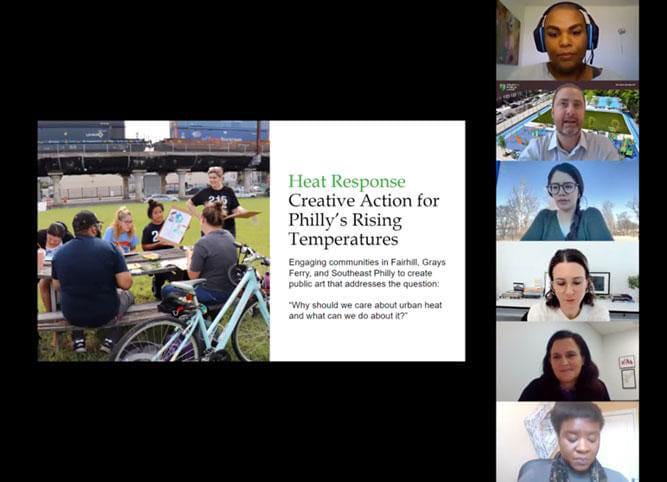Art in action!

For over two years, collaboration, connection, and conversation have been at the core of the Heat Response PHL project. We recently gathered for a virtual discussion to explore these important themes with our friends at the Pennsylvania Horticultural Society (PHS), Amber Art and Design, UC Green, and project funder The Pew Center for Arts & Heritage. At the heart of our discussion was how art can be a powerful tool to facilitate engagement and support more resilient communities.
At its conclusion, three key lessons from the experiences of our participants stand out and offer meaningful guidance for future work.
1. Art Creates A Common Language
“Art allows us to connect the past and the present, and it allows us to envision what the future can look like,” Heat Response artist and founder of Amber Art and Design Linda Fernandez shared.
Fernandez and fellow artist Keir Johnston created the coloring book Seedlings, which was developed with virtual and in-person input from Philadelphia’s Fairhill community members.
TPL organized dozens of neighborhood events that engaged community members, and hundreds of Philadelphia residents participated in art and poetry workshops as part of the Heat Response project.
Using the great talents of local artist teams, our organizations have been able to expand our toolkits when it comes to talking about difficult issues and topics like climate change, equitable access to trees, green space, and extreme urban heat.
2. Connected Communities Are More Resilient
Creating art creates opportunities for communities to engage, collaborate, and connect with one other.
Owen Franklin, TPL Pennsylvania State Director and Heat Response PHL Project Lead, noted “art can really unite people in a dynamic, exciting conversation that is fluid, adaptive, and can touch us in ways that we don’t often get to enjoy,” he said. “There’s nothing more powerful in a resilient community than connection. A connected community is a resilient community.”
“Fundamentally, what we look to do is help people understand that they have a shared priority,” TPL’s Franklin said. “They have a shared challenge and a shared opportunity to work together, to support one another, to do more together than they can apart.”
“We saw sTREEtwork as a really powerful opportunity to catalyze new interests and invite more people in to help make our communities healthier, safer by planting more trees,” said Julianne Shrader Ortega, Vice President, Chief of Healthy Neighborhoods for the Pennsylvania Horticultural Society. “To figure out how we can spark these conversations and mobilize action for planting trees and gardening is for the greater good of all of us.”
3. Green Solutions Uplift Communities
Whether it’s more trees, parks, or open spaces, these green solutions support physical and mental wellbeing. They cool the environment, give us space to exercise and recreate and create reprieves for mental health and relaxation.
The sTREEtwork program from PHS aims to use art to animate how we live among trees, how we perceive them, and how we imagine our future cohabitation with trees. For the sTREEt Work project, PHS partners with groups like UC Green, which amplifies the interests of residents for more trees and green space and to plant and care for trees in local neighborhoods.
“The opportunity to partner with sTREEt Work seemed like a natural synergy to amplify our tree plantings, to create some space that is fun and festive, and invites folks to be inquisitive about what’s going on,” said Kiasha Huling, Executive Director of UC Green. “Trees tend to do that, they’re also a convener in bringing communities together, and certainly art does as well.”
Ready to learn more?

